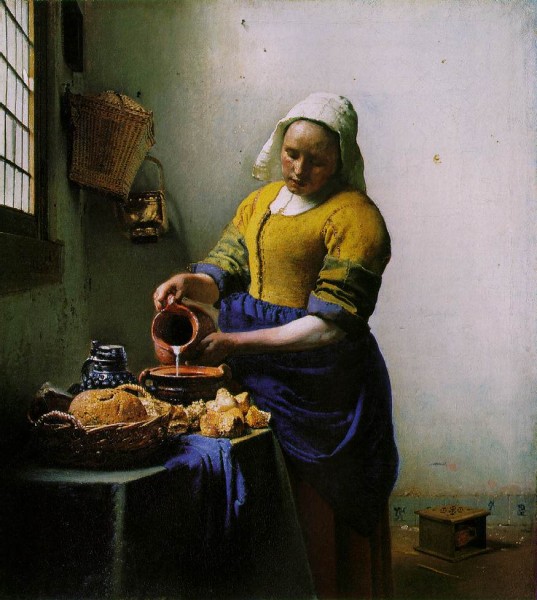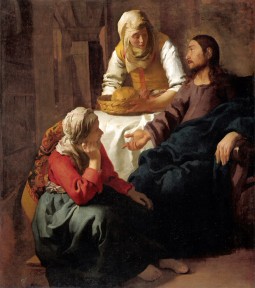 Jan Vermeer, The Milkmaid, c. 1660, oil on canvas, 17.9” x 16.1”, Rijksmuseum, Amsterdam, Photo by jimmiehomeschoolmom via Flickr, Creative Commons Attribution 2.0 Generic License.
Jan Vermeer, The Milkmaid, c. 1660, oil on canvas, 17.9” x 16.1”, Rijksmuseum, Amsterdam, Photo by jimmiehomeschoolmom via Flickr, Creative Commons Attribution 2.0 Generic License.
By now, you may have heard about Pei-Shen Qian, the Chinese artist living in Queens, NY who forged over 60 paintings by Abstract Expressionist artists such as Mark Rothko, Franz Kline and Jackson Pollock. An art dealer from Long Island, Glafira Rosales, recruited Qian to create the forgeries and then fabricated provenances for them before selling them to several prominent galleries over the course of fifteen years. The dealer made millions of dollars from the forgeries. The artist made only a few thousand dollars per painting.
In almost every case of forgery, the artist’s motivation is recognition and success – even if it is associated with someone else’s name. Usually, the artist feels underappreciated and is not critically or commercially successful and fooling everyone – the collectors, appraisers and art historians – gives the artist great satisfaction. This appears to be the case with Mr. Qian.
The dealer’s motivation, naturally, is money.
What’s most interesting here is how the scam can be so successful. Why is it so easy to dupe an art-buying public? How can the “experts” be so easily fooled? Mr. Qian made decent attempts, but there really is no faking a Jackson Pollock. Pollock’s paintings are all process and technique and 100% unique to him. So how were these two able to trick people for so long?
The answer is simple: wishful thinking. The art-buying public and the experts just really wanted the paintings to be authentic.
This is similar to what happened in the Netherlands right after World War II when a forger named Han van Meegeren fooled art historians into believing that his painting was an original by Jan Vermeer, a celebrated 17th-century artist.
 Early in his career, Vermeer favored religious subject matter, as in his Christ in the House of Mary and Martha (Jan Vermeer, 1654-1655, oil on canvas, 62.4” x 55.7”, National Galleries of Scotland, Edinburgh, Public Domain via Wikimedia Commons, see above). Later he turned his interest to everyday subjects, as in his Milkmaid, and used a camera obscura, a type of shadow box, to mark out the space in his compositions. Because art historians did not give enough credit to the artist’s agency, thinking that style is generated with a life and pattern of its own, they made a colossal error in judgment when, in the 1940s, they were thrilled to have discovered what they believed was the missing link between Vermeer’s two stylistic phases: a painting with a religious subject and the naturalistic sense of space that was found in the artist’s later work, the forgery of the Supper at Emmaus by Han van Meegeren. (Click here to see the painting. No image is available for reuse on this website.)
Early in his career, Vermeer favored religious subject matter, as in his Christ in the House of Mary and Martha (Jan Vermeer, 1654-1655, oil on canvas, 62.4” x 55.7”, National Galleries of Scotland, Edinburgh, Public Domain via Wikimedia Commons, see above). Later he turned his interest to everyday subjects, as in his Milkmaid, and used a camera obscura, a type of shadow box, to mark out the space in his compositions. Because art historians did not give enough credit to the artist’s agency, thinking that style is generated with a life and pattern of its own, they made a colossal error in judgment when, in the 1940s, they were thrilled to have discovered what they believed was the missing link between Vermeer’s two stylistic phases: a painting with a religious subject and the naturalistic sense of space that was found in the artist’s later work, the forgery of the Supper at Emmaus by Han van Meegeren. (Click here to see the painting. No image is available for reuse on this website.)
It’s hard to believe that anyone would think that Vermeer painted the Supper at Emmaus since Van Meegeren was such an awful artist.
Van Meegeren eventually had to confess to making Vermeer forgeries to spare himself years in prison for war crimes.
During World War II, one of Van Meegeren’s forgeries, Christ with the Adulteress, made its way into the collection of Hermann Göring. It was traced back to the artist, and in 1945 Van Meeregen was brought to trial for selling a Vermeer to the Nazis, which was tantamount to collaborating with the Nazis and plundering Dutch national property, which could have resulted in an extended prison sentence. Van Meegeren had no choice but to confess to the forgeries.
“Fools!” he told investigators, “I sold no great national treasure—I painted it myself!”
Fools, indeed.
 Early in his career, Vermeer favored religious subject matter, as in his Christ in the House of Mary and Martha (Jan Vermeer, 1654-1655, oil on canvas, 62.4” x 55.7”, National Galleries of Scotland, Edinburgh, Public Domain via Wikimedia Commons, see above). Later he turned his interest to everyday subjects, as in his Milkmaid, and used a camera obscura, a type of shadow box, to mark out the space in his compositions. Because art historians did not give enough credit to the artist’s agency, thinking that style is generated with a life and pattern of its own, they made a colossal error in judgment when, in the 1940s, they were thrilled to have discovered what they believed was the missing link between Vermeer’s two stylistic phases: a painting with a religious subject and the naturalistic sense of space that was found in the artist’s later work, the forgery of the Supper at Emmaus by Han van Meegeren. (Click here to see the painting. No image is available for reuse on this website.)
Early in his career, Vermeer favored religious subject matter, as in his Christ in the House of Mary and Martha (Jan Vermeer, 1654-1655, oil on canvas, 62.4” x 55.7”, National Galleries of Scotland, Edinburgh, Public Domain via Wikimedia Commons, see above). Later he turned his interest to everyday subjects, as in his Milkmaid, and used a camera obscura, a type of shadow box, to mark out the space in his compositions. Because art historians did not give enough credit to the artist’s agency, thinking that style is generated with a life and pattern of its own, they made a colossal error in judgment when, in the 1940s, they were thrilled to have discovered what they believed was the missing link between Vermeer’s two stylistic phases: a painting with a religious subject and the naturalistic sense of space that was found in the artist’s later work, the forgery of the Supper at Emmaus by Han van Meegeren. (Click here to see the painting. No image is available for reuse on this website.)
